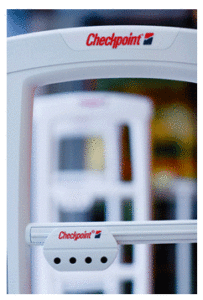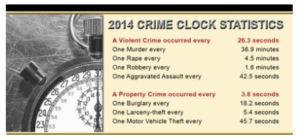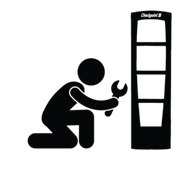It is evident that small businesses and big retail chains have problems dealing with shoplifting and employee theft. Technology that helps them prevent shoplifting is an investment that their store cannot refuse. But, having the technology that helps prevent shoplifting is only a small part of the solution. Having employees trained and knowledgeable should be a big part of their strategy to prevent shoplifters. Do they know the steps to take when apprehending a shoplifter? Are they knowledgeable about the rights, and store policies regarding shoplifters? Technology can certainly help, but training your employees is a big part of the solution to stop shoplifting in your store.
Creepy Mickey Mouse arrested for shoplifting
That is one goofy mugshot.
A 22-year-old female tourist inside a Mickey Mouse outfit was busted in Germany for trying to steal nail clippers and a bottle of shampoo — and hiding the pilfered goods in her gigantic head, according to Central European News.
Police in the southwest city of Kaiserslautern released the suspect’s mugshot, erring on the side of hilarity and the woman’s privacy.
“The good news for Disney fans is that Mickey Mouse has been released from prison,” according to a spokesman for regional police in the state of Rhineland-Palatinate.
How to prevent shoplifting: 10 ways to protect your retail business
Every week there’s a new story – someone has tried to shoplift something in brazen or bizarre fashion.
Whether it’s the well-known trick of trying to secrete something away in a bag or under clothes, or something more devious, like the people who set up a fake company hiring ‘mystery shoppers’ and ordering them to steal, there are those out there who will try to pull a fast one on you.
With that in mind, these are our top 10 tips for preventing theft, and what to do if you do fall victim to it.
10 tips to prevent shoplifting
1. Know how to spot a shoplifter
One of the first things to prepare yourself and your employees for is how shoplifters are likely to behave. That way you’ll be able to spot them more easily and hopefully be able to stop them.
If someone is planning to shoplift from you, they may well display the following behaviours:
- Attempting to avoid being noticed
- Looking nervous, sweating or becoming flushed
- Picking up and putting back the same items repeatedly
- Paying more attention to what’s around them than the product in their hand or on the shelves in front of them
- Wearing large coats, even in hot weather, or carrying large bags
Of course, this behaviour doesn’t necessarily mean that someone is planning to steal from you, but they’re signs worth looking out for.
Security Cameras with Facial Recognition: A Game-Changing Technology for Retailers
Retail security systems with facial-recognition technology are becoming more prevalent in stores.
EDITOR’S NOTE: This article is based on the experiences of a well-known retailer who implemented a facial-recognition security camera system. Because of the potential value of this technology to the retail industry as well as the critical issues surrounding its deployment, the executive who leads this initiative approached the magazine to offer his insights on the condition of anonymity. Therefore, the names of the individual and the company have been changed.
“We’re seeing shoplifters—known shoplifters—come up to us and ask permission to buy something.” Is this some kind of loss prevention Twilight Zone, or the delusions of a loss prevention associate who has spent too many hours watching surveillance video? No, this is everyday life in stores at a leading retailer who has recently deployed a facial-recognition system. And it’s just one of the changes that have led the company’s head of LP to call facial recognition a game-changing loss prevention technology.
“We now know within seconds of a person walking in the store if they’ve previously been caught stealing from us,” says Tom Smith, vice president of loss prevention for Store-Mart. “We now know which hours of the day see the most shoplifter activity. We now know that 26 percent of the people we detain, we see again in the brand within one month, on average 13 days later. We never had a way of knowing things like this before. This is stuff that LP associates will salivate over. It’s going to be a game changer.”


 forbid a competitive system). It is installed and your shoplifting losses go down. They will! The simple act of installing a system will make a percentage of your shoplifters go elsewhere.
forbid a competitive system). It is installed and your shoplifting losses go down. They will! The simple act of installing a system will make a percentage of your shoplifters go elsewhere.


 ch these live webinars as reasonably often as you need. Staff turnover, promotions, follow up training, one employee or fifty…. Just schedule the session. Oh, by the way. I will also provide you with 15 draft LP Policies and Procedures that you can customize to your operation. Shoplifting, employee theft, robbery, key control…..
ch these live webinars as reasonably often as you need. Staff turnover, promotions, follow up training, one employee or fifty…. Just schedule the session. Oh, by the way. I will also provide you with 15 draft LP Policies and Procedures that you can customize to your operation. Shoplifting, employee theft, robbery, key control…..
 If you work in retail then you know theft is a big problem. The theft of supplies, merchandise, time and money are just a few of the things managers have to deal with daily. They have to address it on many fronts (i.e., impulse and professional shoplifters, employees and their friends and families, vendors).
If you work in retail then you know theft is a big problem. The theft of supplies, merchandise, time and money are just a few of the things managers have to deal with daily. They have to address it on many fronts (i.e., impulse and professional shoplifters, employees and their friends and families, vendors). Retail alarms are necessary to ensure a store is protected against break-ins and even theft from within. I know from personal experience that they work. As a Loss Prevention Manager I once had to respond to a burglary alarm when two young men threw a cement block through the front doors of my store in the middle of the night. I also responded to a number of false alarms due to system errors and failures. As a Manager On Duty I know that it can be stressful wondering if you locked all the doors and set the alarm at the end of the night. With those situations in mind, I would like to provide some practical tips to help avoid excessive false alarms and worry about building security.
Retail alarms are necessary to ensure a store is protected against break-ins and even theft from within. I know from personal experience that they work. As a Loss Prevention Manager I once had to respond to a burglary alarm when two young men threw a cement block through the front doors of my store in the middle of the night. I also responded to a number of false alarms due to system errors and failures. As a Manager On Duty I know that it can be stressful wondering if you locked all the doors and set the alarm at the end of the night. With those situations in mind, I would like to provide some practical tips to help avoid excessive false alarms and worry about building security. What can make life miserable for a Human Resources or Hiring Manager? In the right circumstances, a Loss Prevention Manager can be the cause of much consternation for a Human Resources Manager. When more than one employee is being apprehended or fired for theft at the same time it requires shifting schedules, moving people around and hiring new people to take the place of the employees being removed. What makes it even more difficult for a retail H.R. Manager is if the employees work in a specialized job function. I confess (with a smile on my face as I write this) that I was responsible more than once for putting a Human Resource Manager in this predicament during my Loss Prevention Manager career. Don’t misunderstand, I was not taking pleasure in the misery of the Human Resource Manager or the Department Manager, for that matter; I was enjoying closing an investigation that netted around five employees in total, three who worked in the one area.
What can make life miserable for a Human Resources or Hiring Manager? In the right circumstances, a Loss Prevention Manager can be the cause of much consternation for a Human Resources Manager. When more than one employee is being apprehended or fired for theft at the same time it requires shifting schedules, moving people around and hiring new people to take the place of the employees being removed. What makes it even more difficult for a retail H.R. Manager is if the employees work in a specialized job function. I confess (with a smile on my face as I write this) that I was responsible more than once for putting a Human Resource Manager in this predicament during my Loss Prevention Manager career. Don’t misunderstand, I was not taking pleasure in the misery of the Human Resource Manager or the Department Manager, for that matter; I was enjoying closing an investigation that netted around five employees in total, three who worked in the one area.


